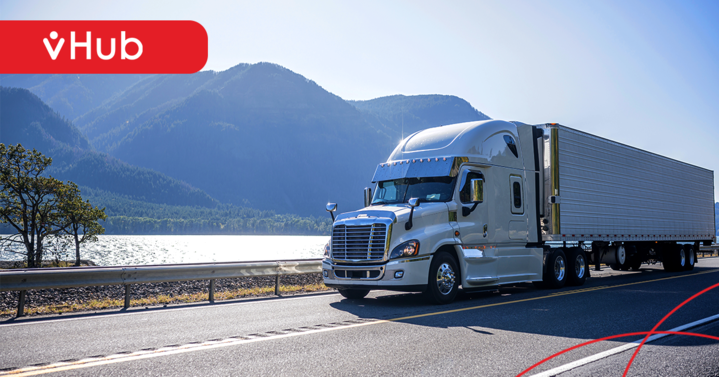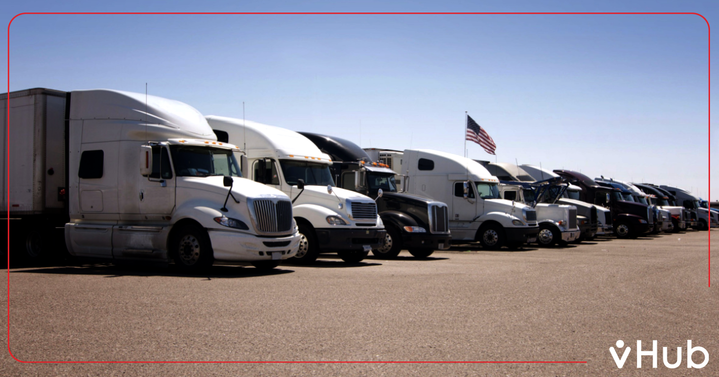In today’s tumultuous supply chain market, drivers know how to keep tractor trailers full and on the road. Keeping up with the ever-changing market trends and customer demands presents a unique challenge for drivers and brokers. In addition to market volatility, there is an ongoing concern over capacity crunches, driver shortages, and trailer availability.
As the Journal of Commerce pointed out, “not only is operating capacity being curbed by record supply chain delays so far in the second quarter, but firms have also been increasingly unable to hire sufficient staff. Hence backlogs of work are building up at an unprecedented rate, as firms struggle to meet demand.”
Keeping trucking trailers filled and on the road is the key to fighting trucking inflation, increasing rates, and higher expenses. It is easier to maximize freight capacity by utilizing semitrailer pools, integrating modern collaborative platforms, and maximizing support center services through advanced supply chain management.
What Are Trucking Trailer Pools, and How Does it Help Improve Freight Capacity and Truckload Management?
Dealing with issues surrounding semitrailer pool trucking capacity, backlogs, and capacity crunch issues represents an ongoing challenge for drivers. Driving a tractor trailer can have great freedom and potential profits, but it can quickly become a nightmare if drivers cannot stay on the road and keep their trucks full. Drivers can overcome these issues and minimize downtime with trucking trailer pools.
With the concept of power pools and trailer hubs, the main goal is to give trailer owners and drivers an easier way to connect and communicate in real-time. When trailer owners have empty trailers available, they can stage them in a common area and list the availability of each trailer on a digital dashboard or platform. From there, drivers can check to see what trailers are available and reserve them for loads lined up. They can go to the holding site, hook up the trucking trailer, make whatever runs they need, and then drop the trailer off when they are done for another driver to utilize.
Trailer pools make it easier for truckers to execute a higher number of drop-and-hook loads than the often tedious and involved live loading and unloading process. Instead of waiting for someone else to load or unload and approve dispatch, the driver can drop an empty trailer and immediately head off to another location or simply pick up an empty container and start another load. These are especially important when considering inflation and transportation expenses.
According to reports by Freightos, “Inflation caused by climbing oil prices and made worse by the war in Ukraine appears to be curbing European demand for imports. Rates from Asia-N. Europe has declined 17% since the end of January.”
Shippers can also optimize routine processes to reach their operational efficiency. Maintaining optimal load volume and driver capacity are primary concerns for drivers. The instability of global conflicts creates market conditions that make trailer pools ideal for trucking trailer utilization and truckload management. Countless news stories and pressroom releases today speak to capacity concerns and how innovative solutions impact the market positively.
Why Full Dropped Trailer Lots Result in Problems for the Trucking Industry
Managing capacity and keeping truckers on the go hauling full trucking trailers is an ongoing challenge, especially with the level of market instability and volatility that is present today. Several issues present a challenge to the trucking industry as a whole. Setting up and maintaining semitrailer pool trucking capacity is a huge first step that is often the hardest for companies to make.
According to DAT, one of the most significant issues facing the tractor-trailer driver network today is the cost involved with setting up trailer pools. “New van trailer [costs] depend on specs such as stronger floors or lightweight materials. In a live load / unload scenario, there’s a 1:1 ratio of trailer to power unit (tractor). Most trailer pools have a ratio between 3:1 and 5:1. All of those extra trailers add costs to the carrier, even as they improve driver retention and minimize detention.”
Trailer pools can improve freight capacity, driver retention, load throughput, and overall productivity, but they come with a burden that businesses must address. With the correct predictive planning and optimizations in place, semitrailer pools can help improve capacity and boost productivity.
Answering the Dilemma of Trucking Trailer Shortages With a Semitrailer Pool
Collaboration between available drivers and dispatchers is at the heart of semitrailer pools. Drivers want moves, and dispatchers may need to move empty trailers from one location to another. These two groups need a common point of contact to find those moves more easily, and vHub, a digital semitrailer pool, achieves this goal.
A semitrailer pool connects fleet dispatchers and drivers to trailers requiring repositioning as needed. This pool approach makes it possible to move idle cargo capacity while evenly spreading trailers’ flow and distribution.
For example, a fleet has empty trailers sitting at a distribution center where they are not needed. Those trailers could be moved to another hub and used where shippers are desperate for capacity. The tractor trailers can haul cargo while also relocating to places where they can be more beneficial to the supply chain.
Several issues affect the trucking industry today, including the continued shortages and capacity crunches. As highlighted in an April 2022 article by CBS News, the main goal for any freight company is to keep up with market trends and overcome driver and capacity shortages to keep profit margins as high as possible. Some of the biggest challenges a trailer pool can address concerning the trucking trailer shortage today include:
- Lower profits and income
- Higher expenses and fees
- Driver shortage impact
- Backlogs complications
- More idle/dwell time
- Trouble securing driver capacity
- Wasted resources and assets
- Time-intensive management
- Problems with a freight capacity
- An overall decrease in productivity
Maximizing the efficiency each time a trucking trailer is moved by either using it for hauling, relocation to other distribution centers, or a combination of both, is critical for addressing the issue of trailer and capacity shortages in the market today.
Trucker Benefits of Using a Trucking Trailer Pool
Semi pools allow fast and reliable access to trailers and bring many incredible benefits to truckers and drivers. Truckers can easily overcome a range of challenges with the services provided by trailer pool services. Benefits of trucking trailer pool access for drivers include:
- Flexibility to improve freight company operations overall.
- Scalability to adapt to shifting market trends and consumer demands.
- Collaboration allows for easier back-office operations.
- Scheduling confidences that make freight capacity easy to maintain.
- Adaptability and insights that will enable predictive planning.
- Customizations to keep customers’ needs front and center at all times.
- Insights allow for faster and better responses to capacity issues.
- Reliability to handle a wide range of loads and shipment types.
- Faster and easier loading, unloading, and delivery.
- Improved overall performance throughout the entire network.
Trailer Owner Benefits of Working With a Trailer Pool or Network
Keeping up with current market trends and securing a competitive advantage is one of the most significant benefits trailer owners and managers can gain from capitalizing on universal trailer pools. Other benefits include a range of front and back-office improvements, which include:
- Maximum utilization of available trucking trailers.
- Improved overall productivity and profitability.
- Better ROI for trailer purchase and upkeep.
- Ability to provide more capacity to the market.
- It’s easier to get drivers to move/reposition trailers.
- More insight into current trailer location and movement.
- Collaborative opportunities become easier.
- Mutually-beneficial relationships with a freight company.
- Higher levels of productivity overall.
- Better management of time and resources.
Leverage Untapped Semitrailer Capacity With the vHub Platform and App
Capacity issues and concerns remain high, especially in light of ongoing market disruptions and economic uncertainty. The concept of a universal trucking trailer pool can help both owners and drivers capitalize on available capacity and maximize overall productivity. Leveraging tractor trailer availability and driver capacity make riding the ever-shifting waves of market trends and customer demands easier.
There is a wealth of untapped trailer capacity unseen due to poor supply chain visibility and networking. The right technology, apps, tools, and platforms make bringing the two sides together easier. With vHub, trailer owners can maximize profits and ROI while drivers can likewise boost productivity and overall profits by matching driver need with trailer availability- all in real-time. Contact vHub today to learn more.



